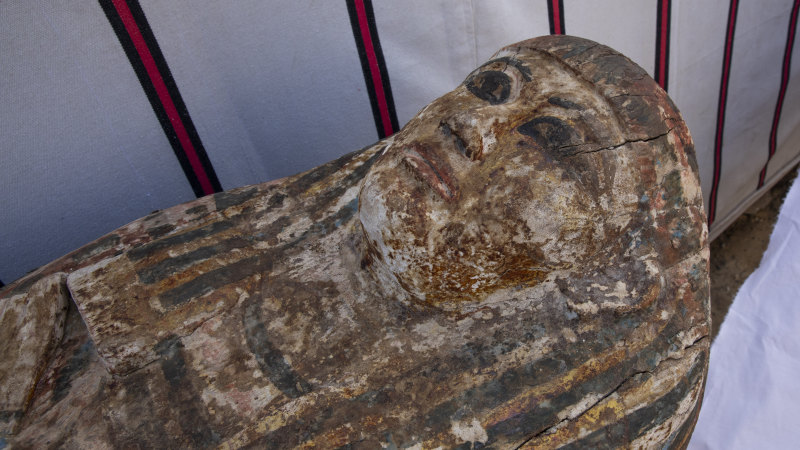On Saturday, Egyptian antiquities minister Khaled el-Anany revealed a selection of newly discovered mummies, tools, coffins and wooden masks found during excavations of a royal necropolis.

The minister showed off the new finds after opening two nearby pyramids to the public Saturday, according to his department. Authorities posted images of the ancient remains—some of which were well preserved—to social media.
The remains were found near King Sneferu’s 4,600-year-old “bent” pyramid and a neighboring structure that may have belonged to his wife, Hetepheres. The two sites are now open to tourists for the first time in decades.

Visitors will be able to enter two rooms at the heart of the Bent pyramid via a somewhat cramped 260-foot long tunnel.
Per Reuters, Mostafa Waziri, secretary general of Egypt’s Supreme Council of Antiquities told reporters: “When we were taking those objects out, we found…a very rich area of hidden tombs.”
The two pyramids are located at the Dahshur royal necropolis, some 25 miles south of Cairo.

Sneferu’s 330-foot tall “bent” pyramid—closed since 1965—is well-known for its unusual shape. Builders attempting to create the smooth-sided pyramid had to change the walls’ angles after cracks started to appear in the structure, Waziri explained. This gave the pyramid a strange, bent form.
Professor Joann Fletcher from the U.K.’s University of York, who was not involved in the opening, told Newsweek this pyramid is “a wonderful example of the way in which the ancient Egyptians were still developing their funerary architecture.”

As their first attempt to build a classic, smooth-sided pyramid, following the construction of the Step Pyramid of Sakkara in around 2650 BC, it involved “considerable trial and error.”
She added: “It marks the very moment when, half-way through the building work, they realized the angle was too steep so had to reduce it resulting in its characteristic ‘bent’ shape—with this sudden change of plan fixed in stone for posterity.”
The ancient Egyptian architects learned from their mistakes and went on to build a second, successful pyramid for Sneferu: the 340-foot tall, smooth-sided Red Pyramid.
Mohamed Shiha, director of the Dahshur site, told reporters: “Sneferu lived a very long time…the architects wanted to reach the complete shape, the pyramid shape.”
Sneferu, who also finished work on a step pyramid for his father, King Huni, was “Egypt’s greatest ever pyramid-builder,” according to Fletcher.

It’s thought the Old Kingdom Pharaoh is buried inside the structure, named for its rusty-colored construction materials. Sneferu’s son, Khufu, went on to commission the Great Pyramid of Giza, which stands less than 20 miles away.
The “perfectly-shaped” Red Pyramid served as a model for King Khufu’s own masterpiece, Fletcher said. “But whereas Giza is now a very busy and noisy destination, the tranquil desert backdrop of the Dahshur pyramids really does take the visitor back in time,” she added.
